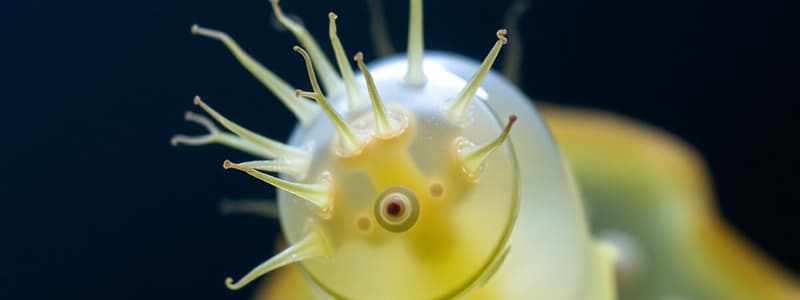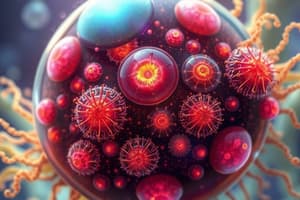Podcast
Questions and Answers
Which characteristic distinguishes diplomonads from other protists?
Which characteristic distinguishes diplomonads from other protists?
- Formation of intricate silica-based shells known as frustules.
- Having modified mitochondria called mitosomes and multiple flagella. (correct)
- Presence of a single flagellum used for movement.
- Ability to perform photosynthesis in low-light conditions.
How do kinetoplastids, such as Trypanosoma cruzi, obtain their nutrition?
How do kinetoplastids, such as Trypanosoma cruzi, obtain their nutrition?
- By trapping and ingesting smaller microorganisms.
- Through photosynthesis, using chloroplasts acquired via endosymbiosis.
- By absorbing nutrients directly from the surrounding aquatic environment.
- As parasitic organisms, absorbing nutrients from a host organism. (correct)
What ecological role do dinoflagellates play in marine ecosystems?
What ecological role do dinoflagellates play in marine ecosystems?
- Serve exclusively as parasites, preying on fish and marine mammals.
- Act as primary producers, forming the base of the marine food web. (correct)
- Primarily function as decomposers, breaking down organic matter.
- Exclusively form symbiotic relationships with corals.
How do foraminiferans contribute to the geological record and what is a key characteristic of their test (shell)?
How do foraminiferans contribute to the geological record and what is a key characteristic of their test (shell)?
How do the structures of radiolarians assist in their survival and ecological function?
How do the structures of radiolarians assist in their survival and ecological function?
Flashcards
Excavata
Excavata
A supergroup of protists including diplomonads, parabasalids, and euglenozoans.
Kinetoplastids
Kinetoplastids
Unicellular, flagellated protozoans characterized by a kinetoplast.
Chromalveolata
Chromalveolata
A diverse group of protists including dinoflagellates, apicomplexans, ciliates, diatoms, golden brown algae, and water molds.
Rhizaria
Rhizaria
Protists characterized by threadlike pseudopodia; includes cercozoans, foraminiferans, and radiolarians.
Signup and view all the flashcards
Alexanderium cantella
Alexanderium cantella
A type of algae that can cause 'red tides' due to neurotoxins.
Signup and view all the flashcardsStudy Notes
- Protists are classified in the domain eukarya and the kingdom Protista, based on the endosymbiotic hypothesis
- Aerobic bacteria became mitochondria
- Cyanobacteria became chloroplasts.
- Protists vary in size and can be unicellular yet highly complex or colonial.
Nutrition of Protists
- Algae are photosynthetic.
- Protozoans are heterotrophic, ingesting food through endocytosis.
- Some protozoans are mixotrophic, combining autotrophic and heterotrophic nutritional modes.
Life Cycle of Protists
- Protists reproduce asexually.
- Sexual reproduction may occur under unfavorable environmental conditions.
- Spores and cysts, formations of dormant cells, allow them to survive these conditions.
- Cysts may serve as a means of transfer to a new host in parasitic protists.
Biology of Protists
- Protists have enormous ecological importance.
- Photoautotrophs produce oxygen.
- Protists form the foundation of food chains in fresh and saltwater ecosystems.
- Protists are a major component of plankton and suspended in water.
- Protists serve as food for heterotrophic protists and animals.
- Whales feed on plankton, including some of the smallest organisms in the sea.
- The complexity and diversity of protists make them difficult to classify.
- Protists are not monophyletic, meaning they do not all belong to the same evolutionary lineage.
- Protists are classified into six supergroups- a taxonomic group below domain and above kingdom
Supergroup Excavata
- Has atypical or absent mitochondria.
- Characterized by distinctive flagella and/or deep (excavated) oral grooves.
- Includes diplomonads, parabasalids, and euglenozoans.
Diplomonads and Parabasalids
- Unicellular and flagellated.
- Endosymbionts and live inside of animals.
- Survive in anaerobic (low oxygen) environments.
- Lack mitochondria and rely on fermentation for ATP production.
- Possess two nuclei and two sets of flagella.
Diplomonads
- Contain two nuclei and two sets of flagella.
- Well known for causing various diseases in humans, such as Giardia lamblia, which causes severe diarrhea.
- Cysts are transmitted in contaminated water, and beavers are important hosts.
Parabasalids
- Possess a unique fibrosis connection between the Golgi apparatus and flagella.
Euglenozoans
- Small freshwater unicellular organisms.
- Possess mitochondria, however, they lack a cell wall and instead have proteins encircling the cell.
- Includes free-living euglenids and parasitic kinetoplastids.
Euglenids
- Asexual, single-celled freshwater protists.
- Some are mixotrophs, some are photoautotrophs, and some are heterotrophs.
- Have flagella and an eyespot that detects light.
- Possess one long flagellum called a tinsel flagellum because of hairlike projections.
- Cell is bounded by a flexible pellicle.
- Contractile vacuole rids the body of excess water.
- Chloroplasts, if present, are surrounded by three membranes rather than two.
- They have a special chloroplast region, the pyrenoid, that produces an unusual carbohydrate called paramylon.
Kinetoplastids
- Unicellular, flagellated protozoans.
- Possess a distinctive kinetoplast, which is a large mass of DNA located in the mitochondrion.
- Trypanosomes are parasitic kinetoplastids.
- Trypanosoma brucei causes African sleeping sickness transmitted by the tsetse fly, causing lethargy due to inadequate oxygen supply to the brain.
- Trypanasmo cruzi causes Chagas disease.
Supergroup Chromalveolata
- Includes two large supergroups: alveolates and stramenopiles.
- Alveolates have single-celled small air sacs beneath the plasma membrane, which supports the cell surface and aids in membrane transport.
- Includes dinoflagellates, apicomplexans, and ciliates.
- Stramenophiles include diatoms, golden brown algae, brown algae, and oomycetes.
Dinoflagellates
- Consist of more than 2,000 species.
- Single-celled and bounded by protective cellulose plates impregnated with silicates.
- Features two flagella: one acts as a rudder, and the other causes the cell to spin and move forward.
- Endosymbiotic dinoflagellates called zooxanthellae are found in corals, providing their host with organic nutrients, while corals provide shelter, nutrients, and protection.
- Alexanderium cantella can cause red tide and produce a neurotoxin that kills massive fish.
- Consuming hell break during an outbreak can cause respiratory paralysis in humans.
Apicomplexans
- Also known as sporozoans.
- Non-motile, spore-forming parasites of animals.
- Unique organelle called apicoplast that uses to penetrate the host cell.
- Plasmodium species causes malaria.
- Transmitted by mosquitoes and infect blood cells, common in densely populated, tropical areas of the globe.
Ciliates
- Are among the most complex of the protozoans.
- Hundreds of cilia beat in coordinated rhythm.
- Most ingest their food.
- Divide by transverse binary fission during asexual reproduction.
- They have two types of nuclei: micronuclei, which participate in reproduction, and macronuclei, which control normal cell metabolism.
- Sexual reproduction involves conjugation and exchange of haploid nuclei.
- Ichthyophthirius is an ectoparasitic protozoan that causes ick in fish.
Diatoms
- Single-celled stramenopile with an ornate silica shell.
- Make up an insignificant part of the plankton.
- Reproduce sexually and asexually.
- Are sometimes called a glass shell and are part of Diatimiochenous earth.
Golden Brown Algae
- Have yellow-brown carotenoid accessory pigments.
- Unicellular or colonial.
- Usually have flagella with tubular hairs.
- Many species are mixotrophs.
- Capable of photosynthesis and phagocytosis.
- Contribute to freshwater and marine phytoplankton.
Brown Algae
- Live in colder ocean waters along rocky coasts.
- Morphology: range from small forms with simple filaments to large multicellular forms that may exceed 200 m in length.
- Contain an accessory carotenoid pigment that provides brown color.
- Excess food is stored in a carbohydrate called ;a,amoaram.
- Laminaria (kelp) and Fucus (rockweed) are common intertidal seaweeds.
- Laminaria shows tissue differentiation and transports organic nutrients.
Oomycetes
- Fungus-like diploid protists known as water molds.
- Most live in the water and form furry growths on their food source.
- Some live on land and are parasitic insects and plants.
- Most are saprotrophic and feed on dead, organic matter.
- Responsible for the potato famine in Ireland in the 1840s and the mildew of grapes in France in the 1870s.
- Cell walls are composed of cellulose.
- Asexual reproduction produces flagellated diploid cells/zoospores.
- Meiosis produces sexual haploid gametes.
Supergroup Rhizaria
- Composed of cercozoans, foraminiferans, and radiolarians.
- Classified together based on rRNA sequence data.
- The members of this group do not share very many morphological characteristics.
- Commonalities include thin, threadlike pseudopods, and many produce a shell that can be fossilized.
Cercozoa
- Have pseudopods or flagella and an outer net-like appearance.
- Some species have sausage-shaped endosymbiotic cyanobacteria.
- Endosymbiosis event occurred recently, 100 million years ago.
Foraminiferans
- Organisms with fine, threadlike pseudopods.
- Their skeleton is known as a test.
- The tests are composed of calcium carbonate that have multiple chambers.
- Pseudopodia extend through openings in testes.
- Each geological period has a distinctive foraminifera form.
- They can be used as index fossils to date sedimentary rock.
- Ancient deposits formed the white cliffs of Dover.
Radiolarians
- Their test is composed of silicon and used as indicators of oil deposits on land and sea.
- Fossils date back to the Precambrian period.
Studying That Suits You
Use AI to generate personalized quizzes and flashcards to suit your learning preferences.




